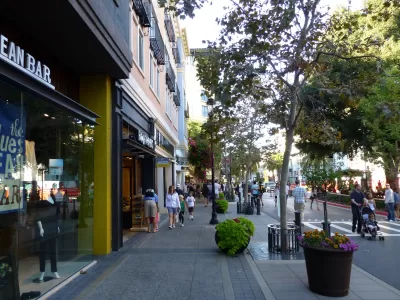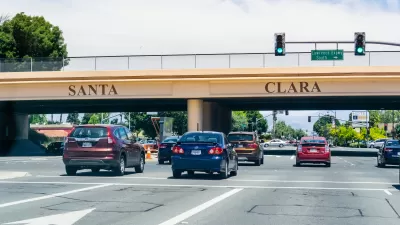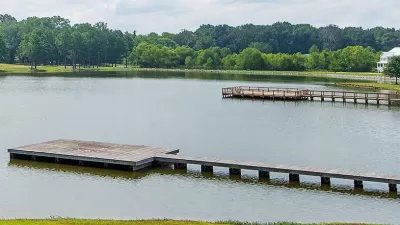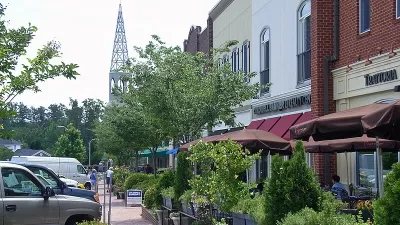The product of a single developer, San Jose's Santana Row is a pocket of urbanism in a sea of sprawl. But can it influence development patterns beyond its bounds, and should it?

For the Congress for the New Urbanism's Public Square, Robert Steuteville discusses the merits of intentionally "urbanist" developments like San Jose's retail-oriented Santana Row. "Santana Row is better than the usual Silicon Valley sprawl, but does it represent real progress—or is it merely dressing up a mess of disconnected development?"
Steuteville notes that in Silicon Valley, "The tech industry did not create sprawl. It accelerated sprawl by creating hundreds of thousands of high-paying jobs that kicked housing demand into overdrive. But [sprawl] was formed by, among other factors, government-adopted zoning codes and publicly built road systems that funnel traffic from housing and shopping pods onto large, wide thoroughfares."
The article covers how Santana Row interacts with neighboring arterials and whether a centrally-planned development can truly influence the surrounding sprawl.
Steuteville argues that developers alone cannot reshape urban environments. "The reality is that new urbanists have made far less impact on transportation engineering than they would like. [...] Expecting a developer to solve a thoroughfare or context problem that exists at a far larger scale than the development site is unrealistic."
FULL STORY: Genuine change or lipstick on a pig?

Study: Maui’s Plan to Convert Vacation Rentals to Long-Term Housing Could Cause Nearly $1 Billion Economic Loss
The plan would reduce visitor accommodation by 25,% resulting in 1,900 jobs lost.

North Texas Transit Leaders Tout Benefits of TOD for Growing Region
At a summit focused on transit-oriented development, policymakers discussed how North Texas’ expanded light rail system can serve as a tool for economic growth.

Using Old Oil and Gas Wells for Green Energy Storage
Penn State researchers have found that repurposing abandoned oil and gas wells for geothermal-assisted compressed-air energy storage can boost efficiency, reduce environmental risks, and support clean energy and job transitions.

Private Donations Propel Early Restoration of Palisades Playground
Los Angeles has secured over $1.3 million in private funding to restore the Pacific Palisades playground months ahead of schedule, creating a modern, accessible space that supports community healing after recent wildfires.

From Blight to Benefit: Early Results From California’s Equitable Cleanup Program
The Equitable Community Revitalization Grant (ECRG) program is reshaping brownfield redevelopment by prioritizing projects in low-income and environmental justice communities, emphasizing equity, transparency, and community benefits.

Planting Relief: Tackling Las Vegas Heat One Tree at a Time
Nevada Plants, a Las Vegas-based nonprofit, is combating the city’s extreme urban heat by giving away trees to residents in underserved neighborhoods, promoting shade, sustainability, and community health.
Urban Design for Planners 1: Software Tools
This six-course series explores essential urban design concepts using open source software and equips planners with the tools they need to participate fully in the urban design process.
Planning for Universal Design
Learn the tools for implementing Universal Design in planning regulations.
Ascent Environmental
Borough of Carlisle
Institute for Housing and Urban Development Studies (IHS)
City of Grandview
Harvard GSD Executive Education
Toledo-Lucas County Plan Commissions
Salt Lake City
NYU Wagner Graduate School of Public Service





























